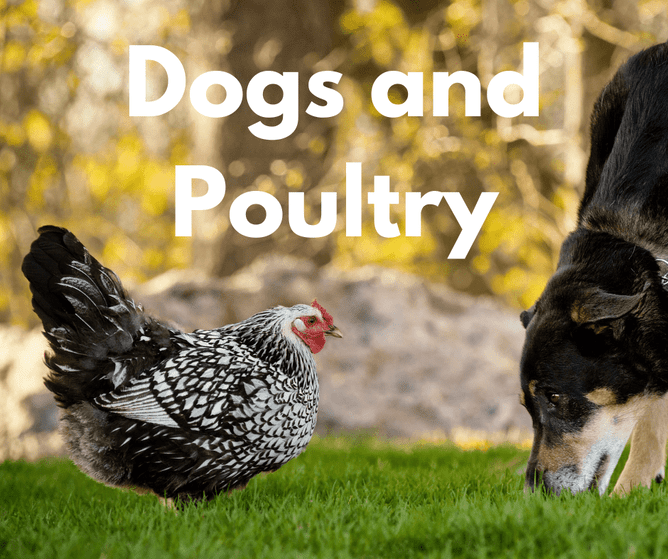Dogs and Chickens
Can Dogs Live with Chickens (and other poultry)?
Yes! They absolutely can. While some dogs may not pay any attention to chickens at all, some dogs have a very high prey drive so let’s dig a little deeper into why that is and how it can be managed…
‘Prey Drive’
Prey drive is the instinctive inclination of a carnivore to find, pursue and capture prey. Dogs like to hunt, especially certain breeds and especially anything small that moves fast. It is worthwhile researching dog breeds and what they were bred to do before combining chickens and dogs together.
Management and Prevention
Your chickens should have a separate area to roam in from your dogs. Don’t take the chance of thinking your dog/s will always be OK with chickens roaming freely around them. Dogs are predators and chickens act as prey. Chickens can panic when being chased and can often injure themselves or die of fright if chased at length.
Training
This is the same process for bringing home a dog to existing chickens, or chickens to an existing dog/s.
Create positive associations, teach your dog what you want them to do, manage and train.
The set up and step 1:
Chickens behind secure fencing.
If you don’t have a fence and have particularly curious chickens, be sure to have a second person to step in just in case.
Try training when your dog is already calm, not hyped up.
Your dog should be on a harness and standard lead.
Start at a distance where your dog notices the chickens but can remain calm.
Reward for calm behaviour.
Mark and treat your dog when they look at the chickens. Refer to our Look At That (LAT) info sheet for the training game.
Use games such as ‘find it’ to reset and break any staring.
Repeat this gradually decreasing the distance between your dog and the chickens providing your dog remains calm.
Be sure to watch your dog's body language.
Step 2:
Introduce a long line. Same set up as step 1, however now you are using a long line of about 5-8 meters.
Continue with the LAT game and decreasing the distance.
Allow your dog to get closer to investigate if they are calm and the chickens are calm.
Reinforce your dog coming back to you once they have investigated the chickens.
Step 3:
This is the final step where you can have the chickens out from behind the fence and go through steps 1 and 2 again.
Training Impulse Control
Teaching your dog wait/stay, leave it and a good recall are all important for living with chickens.
Boundary training can also help – which is teaching your dog to not cross a certain threshold. This takes lots of practice and clear, consistent reinforcement. Reach out to us for assistance with this!
Egg and grain stealers
Lots of dogs will try and steal eggs and even the grain that chickens eat. While raw eggs are great for dogs, you do want to feed them in moderation, so make sure your pooch can’t break into the nesting and feeding areas.
Avoid Punishment
Using punishment not only is unnecessary but it can increase stress (both to dog and owner), create negative associations and unwanted behaviours.
Avoid Complacency
Don’t fall into the trap of thinking your dog/s will be fine with being out with the chickens or left alone, even after long term training.
Dogs are opportunists and will take advantage of a situation if presented with it.
Predation Substitution Training and ‘Unchase’
Designed by trainer Simone Mueller, this is force free anti-predation training which focuses on stopping uncontrolled predatory chasing and to provide safe outlets for your dog’s natural drive. They have some excellent courses to work through to help your dog who likes to chase.
https://predation-substitute-training.com/
Also check out ‘Unchase’ which is a program developed by Aussie trainer Alexis Davison for dogs to learn self-control in the face of exciting chase opportunities.
Some Dogs Just Aren’t Suited To Live With Chickens
Unfortunately, some dogs just can’t be around chickens without getting worked up or wanting to break into their enclosure to chase or kill them.
Also, while some dogs may find it interesting to sit and watch chickens, you don’t want to create an obsession. The aim is for dogs and poultry to live in harmony together, even if there is a permanent fence in between them.
Contact us for more help with a positive dog-poultry relationship.

